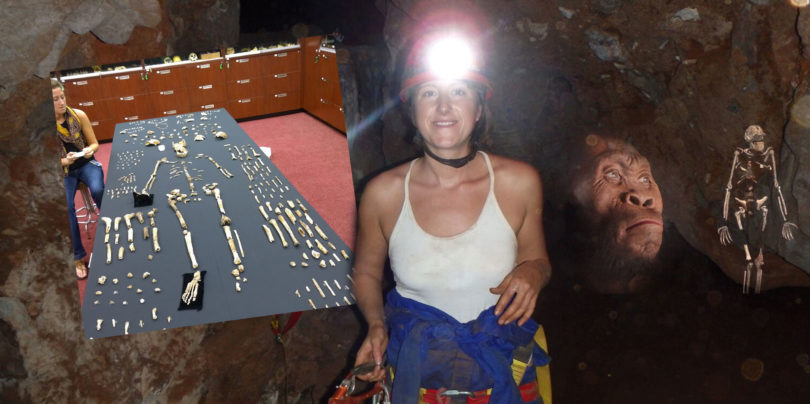By Stephanie Schupska, UGA News Service

It was day 21, the last day of the 2013 Rising Star Expedition, and Hannah Morris crouched next to a long bone, hands sweeping soil away as bone slowly emerged from the cave wall. She was hoping to free one last piece in the puzzle box—the term the crew used for the excavation area in the Dinaledi chamber, or chamber of stars—before heading back to the U.S.
The University of Georgia alumna and current Ph.D. student was slowed by a juvenile mandible fragment, a jawbone coming into view with each sweep of her brush, and ultimately had to leave both for her fellow underground astronauts to uncover in March 2014.
Her 30-minute-plus climb out of the cave was similar to each of the trips she’d made before: squeeze back up a narrow chute, rappel down Dragon’s Back, walk through a large cavern and then kneel down and low crawl through Superman’s Crawl.
The chute narrowed to about seven inches high in some places, and Morris’s ability to fit—she has years of experience caving and climbing—was one of the reasons she was chosen for the expedition.
She climbed back up a ladder and exited the cave, her eyes squinting as they adjusted to the sunlight. What she and 60 other cavers and scientists found at the site is now “challenging the ways we think of what it means to be human,” she said.
Homo naledi
You may have heard about it, flashed across headlines and newscasts, the announcement that a new species of human relative was found in a cave outside of Johannesburg, South Africa. You may have seen a photo of six women dressed in bright blue coveralls, dubbed underground astronauts for their ability to crawl into Dinaledi. That one in the red helmet, the tallest in the group, is Morris. Her own human relative—her brother Brannen—let her borrow his headgear, a piece of home halfway around the world.
It protected her well from the knocks and bumps and collisions that came from being 30 meters below ground.
Two cavers were the first to uncover Dinaledi. They contacted Lee Berger, a research professor at the University of the Witwatersrand in Johannesburg and an explorer-in-residence for National Geographic. He initially hoped the group would uncover one complete skeleton. In the days that followed, they found 15 individuals ranging in age from infant to elderly and removed more than 1,500 bones.
“With almost every bone in the body represented multiple times, Homo naledi is already practically the best-known fossil member of our lineage,” Berger said in a joint press release issued by National Geographic, Whits and the South African Department of Science and Technology/National Research Foundation, who funded the two Rising Star Expeditions and workshop that followed.
Homo naledi was named after the Rising Star cave-naledi means star in Sesotho, a local South African language. And the genus Homo came about because of its “surprisingly human-like features,” said John Hawks of the University of Wisconsin-Madison, the senior author on the paper in the journal eLife that describes the new species.
The species has a smaller brain-about the size of an orange-and very slender body with teeth similar to earliest-known members of the genus Homo habilis and shoulders similar to those of apes. The Homo naledi’s fingers are extremely curved and feet are “virtually indistinguishable from those of modern humans,” said William Harcourt-Smith of Lehman College, City University of New York, and the American Museum of Natural History.
The Homo naledi also did something amazing, something previously thought unique to humans, the researchers theorize: They buried their dead in Dinaledi.
“We explored every alternative scenario, including mass death, an unknown carnivore, water transport from another location, or accidental death in a death trap, among others,” Berger said. “In examining every other option, we were left with intentional body disposal by Homo naledi as the most plausible scenario.”
A journey started on Facebook
Morris was working on St. Catherine’s Island, one of Georgia’s Golden Isles, “having a really amazing, intense dig,” she said, for the Museum of Natural History.
At the end of a long day in the field, she checked Facebook. Berger had posted the job announcement: He and the other senior scientists planning the Rising Star Expedition couldn’t fit through the openings into Dinaledi. They needed scientists who were experienced in climbing and caving to do the primary excavation and “be their arms and legs down there,” she said.
Morris clicked the link, put in her application, got an interview, asked David Hurst Thomas—her boss and one of the most famous archeologists in the U.S.—for the day off, landed the job and was headed to Joburg in the span of three weeks.
Her trek to the chamber of stars started a lifetime before a Facebook post. As the daughter of a geology professor living just above Rome, she spent much of her time outside.
“Northwest Georgia actually has some of the best caving in North America,” she said. “I grew up caving with my father and my family and also doing a little rock climbing. I definitely love caving.”
At UGA, she became interested in archeology—she graduated in 2007 with her bachelor’s degree in anthropology—and “has excavated in some unique and extreme circumstances,” she said, “so I think all of this personal and professional history, these random things, just came together in a cool way.”
Twitter and choosing a faster way to share history’s secrets
Morris’s parents Billy and Sandra opened their first Twitter account in November 2013. They haven’t used it much since then, but for 21 days their eyes were glued to the news feed, searching for signs that their daughter was safe.
The Rising Star team used Twitter to time-stamp and log important data-including when the underground astronauts entered and exited the cave. One from @LeeRberger on Nov. 15, 2013, at 1:10 a.m. Eastern Time read, “Megan and Hannah coming out of the cave now, Marina heading in – wonderful fossils coming out now #risingstarexpedition.”
That’s the post Morris’s parents were looking for. After spending the evening watching virtually as she started the process, entered Dinaledi and prepared to exit, they could finally relax and get some sleep.
While they were sleeping, paleoanthropologists and scientists were studying bones and scans from the cave. The team didn’t just recover these bones and keep all of the information about them to themselves; they chose open access and public disclosure of the information, an abrupt detour from the way most paleoanthropology digs are traditionally conducted.
“Most of the time, someone finds a bone, they find a tiny fragment of a bone, and they keep it to themselves and don’t publish anything for 10 or 15 years,” she said. “But Rising Star has really changed that a lot. That has been very deliberate, and it’s been really amazing to see just how excited members of the public and students and everyone has gotten about this find.”
Because of the tight space and the inability to get traditional archaeological equipment into the cave, the crew used a 3-D scanner about the size of an iron—waved like you would when covering something with spray paint—to document the process. The detail level, down to sub-millimeter accuracy, is beyond what they could get by documenting the dig in a traditional manner—through notes and traditional photos.
“Pretty soon, almost anyone is going to be able to 3-D print a Homo naledi skeleton, and that’s just amazing,” Morris said. “To have this type of technology and to see it used in this way is just really incredible.”
A workshop—a group of scientists from around the world—completed the process of studying the bones in about two years. The discovery is featured as the cover story of National Geographic magazine’s October issue, available online now at http://natgeo.org/naledi. The NOVA/National Geographic special, “Dawn of Humanity,” will premiere Sept. 16 at 9 p.m. ET on PBS and is streaming online now.
Back in Athens
Morris has just started the second month of her doctorate as an ICON, or integrated conservation, student in the Warnell School of Forestry and Natural Resources and is studying under Elizabeth King, a restoration ecologist and assistant professor. She obtained her master’s degree in anthropology from Ohio State University in 2012 after spending a few years, she says, as a shovelbum, working in Alaska, New York City with the American Museum of Natural History, Mexico and the southeastern U.S.
She’s taking her own detour from paleoanthropology. While she loves excavating and caving and all things involving a dig, she’s set her academic sights on a Ph.D. in determining the implications of human actions on vegetative ecosystems.
“Basically, I’m looking at land-use history—combining a lot of things from archeology and ecology to look at how land use in the past affects ecosystem functioning, and in particular, how it’s affecting vegetation.”







